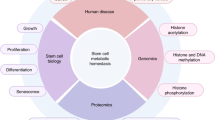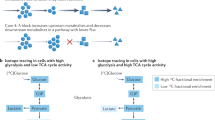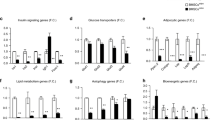Abstract
The rise in the incidence of metabolic disease to become a major public health problem has been met with a substantial increase in research into both the clinical and basic science of metabolism. This work has revealed that the origins of metabolic diseases of adults can begin early in life. Furthermore, the age of onset of symptoms has been rapidly decreasing. Therefore, pediatricians should be critically involved in both the generation of new therapies as well as the institution of measures of disease prevention. This perspective examines how recent advances have improved our understanding of the development of metabolic diseases. A connection between glucocorticoids and the origins of metabolic disease is one enticing clue because of the clinical similarity between patients with glucocorticoid excess and those with metabolic disease. A unifying link was found by investigating the role of glucocorticoids on cell fate and differentiation of mesenchymal stem cells. We conclude that understanding the mechanisms by which glucocorticoids can modify how cell fate decisions are made holds promise for developing new therapies and preventative measures.
Similar content being viewed by others
Main
Understanding cell differentiation has profound and broad implications for both science and health. Glucocorticoids have been used as therapy for a broad range of medical conditions from rheumatoid arthritis to asthma to prevention of transplant rejection (1–3). Glucocorticoids have also been used therapeutically to induce differentiation in situations such as promoting premature lung tissue maturation in the fetus, or facilitating differentiation of immature malignancies such as leukemia and neuroblastoma (4–6). Unfortunately, glucocorticoid therapy is accompanied by numerous undesired side effects, including obesity and diabetes, osteoporosis and myopathy (7). Although these effects might result from the impact of glucocorticoids on a range of mature tissues, a unifying mechanism may contribute to understanding the development of these effects. It is of note that three tissues strikingly affected by glucocorticoids: - fat, bone and muscle - are all derived from a common precursor cell called a mesenchymal stem cell (MSC) (Fig. 1A). Given the known potential for pharmacologic glucocorticoids to induced differentiation, it is plausible that endogenous corticosteroids probably play an important role in the normal cell fate and differentiation process. If this is true, one might ask: Are side effects from pharmacologic concentrations of glucocorticoids a result of altering or exaggerating the same pathways that are found in normal physiology? For example, could excess glucocorticoids alter the normal balanced cell fate decision of the mesenchymal stem cell such that there is a toggle switch toward increased fat and away from bone and muscle lineages (Fig. 1B)?
This Perspective will first briefly review some of the background studies that revealed how glucocorticoids influence adipogenesis and the relationship between this process and systemic metabolism. We will then highlight our recent identification of myostatin as a glucocorticoid regulated gene in mesenchymal stem cells that influences cell fate toward adipogenesis. This work provides one example of a new emerging concept in the field. Finally, we will discuss how the identification of myostatin as a glucocorticoid-induced regulator of mesenchymal stem cell fate has revealed important details about the connection between adipogenesis and systemic metabolism.
GLUCOCOTRTICOIDS, CUSHING'S SYNDROME, AND METABOLIC DISEASE
Cushing's syndrome is the classic and simplest model of glucocorticoid excess. This syndrome occurs via endogenous overproduction of cortisol, i.e., via a pituitary adenoma producing adrenocorticotropic hormone (ACTH) (Cushing's disease), an adrenal tumor producing cortisol or an ectopic ACTH-producing tumor. This syndrome is closely simulated when patients are given exogenous glucocorticoids at pharmacologic levels (iatrogenic Cushing's syndrome). In both endogenous and iatrogenic cases of hypercortisolism, a broad constellation of signs and symptoms develops, including: central obesity, muscle wasting, osteoporosis, thinned skin, hypertension, hyperlipidemia, and insulin resistance (8).
The signs and symptoms of the metabolic syndrome overlap substantially with Cushing's syndrome and include obesity, insulin resistance, hypertension and hyperlipidemia (9). Interestingly, patients with the metabolic syndrome have not been found to have elevations in serum cortisol levels. This led to the hypothesis that local tissue (visceral fat) levels of cortisol may be important in causing the pathology of the metabolic syndrome rather than systemic elevations (9–11). Consistent with this view, transgenic mice that overexpress adipose-specific 11 β-hydroxysteroid dehydrogenase type 1 (11HSD1), which converts inactive 11-dehydrocorticosterone to active corticosterone (the active glucocorticoid in mice), have obesity, hypertension, dyslipidemia and insulin resistance (11). Conversely, 11HSD1 knockout mice are protected from these same metabolic abnormalities (12,13). Finally, elevated 11HSD1 mRNA levels have been detected in subcutaneous adipose tissue in humans with metabolic syndrome (10).
One hypothesis for how insulin resistance develops in the metabolic syndrome is that elevated adipose 11HSD1 produces increased portal, and therefore hepatic, concentrations of glucocorticoids. However, a hepatic specific 11HSD1 transgenic mouse developed only mild insulin resistance with normal glucose tolerance and a modest level of hyperinsulinemia 30 min after an intraperitoneal glucose bolus (14). One interpretation of this finding is that glucocorticoid overproduction locally within adipose tissue may play a more central role in the pathogenesis of insulin resistance. In support of this view, Masuzaki et al. found that transgenic mice over-expressing 11HSD1 in the adipose tissue display increased levels of both adipocyte complement-related protein (Acrp 30) and resistin, both proteins have been proposed to serve as regulators of insulin sensitivity (11). Therefore, in addition to making a connection between Cushing's syndrome and the metabolic syndrome, these data suggest that the insulin resistance found in patients with either (or both) syndromes may be traced to glucocorticoid effects on a single tissue: adipose.
GLUCOCORTICOIDS AND METABOLISM: CONNECTED BY FAT AND FATE
These results imply that the glucocorticoid regulation of adipogenesis is intimately connected to systemic metabolism and insulin sensitivity. Furthermore, the effects of glucocorticoids on adipogenesis may be the causative mechanism by which glucocorticoids alter metabolism and initiate a picture resembling the metabolic syndrome. Therefore, understanding how glucocorticoids alter adipogenesis is critical for improving the health of these Cushing's syndrome patients as well as those with metabolic syndrome. Recent research by Crossno et al. provided the most definitive in vivo evidence that MSCs that reside in the bone marrow serve as a reservoir of precursor cells that are capable of differentiating into mature adipocytes when stimulated by specific signals (15). Signals to produce more adipocytes, such as a high fat diet and possibly increased glucocorticoid levels, result in a cell fate decision in the MSC to become an adipocyte. The MSC then migrates from the bone marrow to a fat depot and differentiates into a mature adipocyte.
The C3H10T1/2 mouse pluripotent MSC line provides a tool for examining the impact of glucocorticoids on this cell fate decision in tissue culture. This cell line is capable of differentiating into adipocytes, myocytes, chondrocytes or osteoblasts in response to distinct signals (16,17). Indeed, dexamethasone (a potent synthetic glucocorticoid) is an essential component of a cocktail of factors capable of inducing the adipocyte fate in this cell line (18).
We recently identified myostatin as a target gene that is regulated by glucocorticoids in the C3H10T1/2 cell line. Myostatin is a member of the transforming growth factor β superfamily (TGFβ). It is a secreted protein that binds to a transmembrane receptor and has been well studied in muscle tissue. We demonstrated that myostatin is sufficient to substitute for dexamethasone to initiate adipogenesis in MSCs (19). While the adipocytes generated with myostatin treatment are unique (as will be discussed below), the fact that myostatin is sufficient to substitute for glucocorticoids to initiate the differentiation pathway suggests that myostatin can play a critical role in initiating adipogenesis and may be relevant to the events that occur in the setting of glucocorticoid excess. Furthermore, mice that have their myostatin gene deleted have a decrease in adipose tissue (in addition to an increase in muscle mass) adding further support for an important role of myostatin in initiating the adipogenesis pathway (20).
We were, therefore, initially surprised by the results we obtained when we created a mouse that overexpressed the glucocorticoid target gene myostatin selectively in adipose tissue. Instead of becoming obese and diabetic, these animals had the complete opposite phenotype: They were resistant to diet induced obesity and had enhanced insulin sensitivity. However, more careful analysis of the adipose tissue from these animals revealed the likely explanation for this conundrum. Rather than having the appearance of normal adipocytes that are large and contain multiple lipid droplets, the adipocytes from the myostatin overexpressing mice were much smaller and contained less lipid per cell. Further molecular and functional analysis revealed that the adipocytes had an immature expression profile and decreased endocrine function (19). Together these data indicated that the adipocytes that formed in these animals were immature. We believe the most likely explanation for these findings is that we have identified the first step in the pathway for glucocorticoid induced adipogenesis (induction of myostatin) but further maturation of the adipocyte requires additional factors. In other words, the process of adipogenesis occurs in dissectible stages and myostatin induces and promotes progression of differentiation from the MSC through to a unique but immature adipocyte and not completely to a mature adipocyte. Importantly, the immature adipocyte appears to protect against the development of insulin resistance and the metabolic syndrome.
CLINICAL IMPLICATIONS
These findings have two important implications: First, the process of glucocorticoid- induced adipogenesis can be modulated. The majority of effort to date in this area has focused on blocking the initiation of adipogenesis. This approach, if successful, has the potential complication that absence of adipose tissue would cause lipodystrophy and the associated significant metabolic complications. The results with myostatin stimulation hold promise that with this approach it may be possible to develop drugs that target the progression of adipogenesis rather than (or in addition to) initiation of adipogenesis. The second implication of our findings is that modulating adipose tissue differentiation in this way can actually improve systemic metabolism and reduce the tendency to develop the metabolic syndrome. This raises the notion that in addition to the familiar “bad” fat that results in obesity and insulin resistance there is a “good” fat that is protective against these same negative outcomes. It has been known for some time that not all fat is created equal. The expansion of different fat depots has distinct effects on metabolism. For example, a large amount of visceral adipose tissue is strongly correlated with the development of the metabolic syndrome while s.c. adipose tissue is not. The results with myostatin-induced adipose suggest that the variability in fat tissue includes the potential to generate adipose tissue with a metabolically favorable profile. The extension of this concept is that with further molecular understanding of how this unique adipose tissue forms, it might be possible to pharmacologically direct adipocytes into this favorable state.
CONCLUSIONS
Our knowledge about adipose tissue and its role in health and disease has grown considerably in the past decade. We have evolved in our understanding of adipose from being simply a storage depot for excess energy to being a dynamic and carefully regulated tissue with broad effects on systemic metabolism. With this expanded knowledge, it has become apparent that pharmacologic use of glucocorticoids disturbs homeostasis in favor of increasing adipose. We postulate that, in addition to other actions of glucocorticoids, this process represents a perturbation or exaggeration of the normal physiologic role of glucocorticoids in cell fate decisions of the mesenchymal stem cell. Understanding this aspect of glucocorticoid physiology may result in the development of improved drugs that can maintain the cell fate decision process closer to normal homeostasis and, therefore, diminish side effects in patients on glucocorticoid therapy. The studies with myostatin also exemplify how increased knowledge of how pharmacologic doses of glucocorticoids cause these side-effects may also provide insight into the normal physiologic regulation of adipose tissue and its effect on metabolism. Along the way new hope has developed that modulating the glucocorticoid pathway might not only provide better drugs with fewer side effects but also reveal a mechanism that can be exploited for the therapeutic benefit of the large patient population with metabolic syndrome and insulin resistance.
Abbreviations
- 11HSD1:
-
11β-hydroxysteroid dehydrogenase type 1
- MSC:
-
mesenchymal stem cell
References
Townsend HB, Saag KG 2004 Glucocorticoid use in rheumatoid arthritis: benefits, mechanisms, and risks. Clin Exp Rheumatol 22: S77–S82
Adcock IM 2003 Glucocorticoids: new mechanisms and future agents. Curr Allergy Asthma Rep 3: 249–257
Almawi WY, Hess DA, Rieder MJ 1998 Multiplicity of glucocorticoid action in inhibiting allograft rejection. Cell Transplant 7: 511–523
Bolt RJ, van Weissenbrunch M, Lafeber H, Delemarre-van de Wall H 2001 Glucocorticoids and lung development in the fetus and preterm infant. Pediatr Pulmonol 32: 76–91
Warrell RP, de The H, Wang Z-Y, Degos L 1993 Acute Promyelocytic Leukemia. N Engl J Med 329: 177–189
Ross RA, Hein AM, Braca JA 3rd, Spengler BA, Biedler JL, Scammell JG 2002 Glucocorticoids induce neuroendocrine cell differentiation and increase expression of N-myc in N-type human neuroblastoma cells. Oncol Res 13: 87–94
Schacke H, Docke WD, Asadullah K 2002 Mechanisms involved in the side effects of glucocorticoids. Pharmacol Ther 96: 23–43
Arnaldi G, Angeli A, Atkinson AB, Bertagna X, Cavagnini F, Chrousos GP, Fava GA, Findling JW, Gaillard RC, Grossman AB, Kola B, Lacroix A, Mancini T, Mantero F, Newell-Price J, Nieman LK, Sonino N, Vance ML, Giustina A, Boscaro M 2003 Diagnosis and complications of Cushing's syndrome: a consensus statement. J Clin Endocrinol Metab 88: 5593–5602
Seckl JR, Morton NM, Chapman KE, Walker BR 2004 Glucocorticoids and 11beta-Hydroxysteroid Dehydrogenase in Adipose Tissue. Recent Prog Horm Res 59: 359–393
Bujalska IJ, Kumar S, Stewart PM 1997 Does central obesity reflect “Cushing's disease of the omentum”?. Lancet 349: 1210–1213
Masuzaki H, Paterson J, Shinyama H, Morton NM, Mullins JJ, Seckl JR, Flier JS 2001 A Transgenic Model of Visceral Obesity and the Metabolic Syndrome. Science 294: 2166–2170
Morton NM, Holmes MC, Fievet C, Staels B, Tailleux A, Mullins JJ, Seckl JR 2001 Improved lipid and lipoprotein profile, hepatic insulin sensitivity, and glucose tolerance in 11beta-hydroxysteroid dehydrogenase type 1 null mice. J Biol Chem 276: 41293–41300
Morton NM, Paterson JM, Masuzaki H, Holmes MC, Staels B, Fievet C, Walker BR, Flier JS, Mullins JJ, Seckl JR 2004 Novel adipose tissue-mediated resistance to diet-induced visceral obesity in 11 beta-hydroxysteroid dehydrogenase type 1-deficient mice. Diabetes 53: 931–938
Paterson JM, Morton NM, Fievet C, Kenyon CJ, Holmes MC, Staels B, Seckl JR, Mullins JJ 2004 Metabolic syndrome without obesity: Hepatic overexpression of 11{beta}-hydroxysteroid dehydrogenase type 1 in transgenic mice. Proc Natl Acad Sci USA 101: 7088–7093
Crossno JT, Majka SM, Grazia T, Gill RG, Klemm DJ 2006 Rosiglitazone promotes development of a novel adipocyte population from bone marrow-derived circulating progenitor cells. J Clin Invest 116: 3220–3228
Pinney DF, Emerson CP Jr 1989 10T1/2 cells: an in vitro model for molecular genetic analysis of mesodermal determination and differentiation. Environ Health Perspect 80: 221–227
Rogers JJ, Young HE, Adkison LR, Lucas PA, Black AC Jr 1995 Differentiation factors induce expression of muscle, fat, cartilage, and bone in a clone of mouse pluripotent mesenchymal stem cells. Am Surg 61: 231–236.
MacDougald OA, Mandrup S 2002 Adipogenesis: forces that tip the scales. Trends Endocrinol Metab 13: 5–11
Feldman BJ, Streeper RS, Farese RV Jr, Yamamoto KR 2006 Myostatin modulates adipogenesis to generate adipocytes with favorable metabolic effects. Proc Natl Acad Sci USA 103: 15675–15680
McPherron AC, Lee SJ 2002 Suppression of body fat accumulation in myostatin-deficient mice. J Clin Invest 109: 595–601
Acknowledgements
The author thanks Keith Yamamoto, David Feldman, and Carlos Pantoja for comments on the manuscript and valuable discussions.
Author information
Authors and Affiliations
Corresponding author
Additional information
This work was supported by National Institutes of Health grants CA20535 and DK073697.
Rights and permissions
About this article
Cite this article
Feldman, B. Is Your Metabolism Determined By (Cell) Fate?. Pediatr Res 61, 636–639 (2007). https://doi.org/10.1203/pdr.0b013e31805d854e
Received:
Accepted:
Issue Date:
DOI: https://doi.org/10.1203/pdr.0b013e31805d854e




